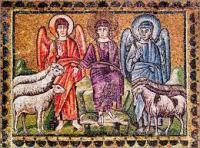
Matthew would appear to be the only gospel in which the Last Judgement is described in the imagery of sheep and goats. In Palestine sheep and goats lived together by day but were separated at night, because the goats were more susceptible to the cold and needed extra protection. There is a dualism here that is disconcerting: surely most people are a mixture of good and bad. However, possibly the separation of the animals is a symbol of the end of time, when good will complete its triumph over evil. Matthew seems to stress this division in earlier images, such as John the Baptist’s winnowing fork (Mathew 3:12-13), which Christ will use to remove chaff from wheat, and the parable of the wheat and the darnel (Matthew 13:24-31). All things will be made clear and justice done.
The Feast of Christ the King was instituted in 1925, at a time when dictators such as Stalin and Mussolini were emerging. The Pope wanted to remind people who the true King is and how differently he governs his people. Nothing much has changed, since there are still many world leaders whose only concern is their own power and prestige. Ezekiel, who prophesied in Babylon, paints a beautiful picture of God as shepherd, tenderly ministering to his flock. This is what the Kingship of Jesus is about. He identifies so completely with his subjects, especially the weak, that the good or bad deeds that we do to our brothers and sisters are done to him.